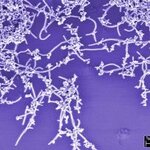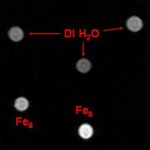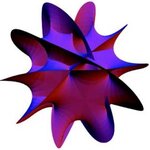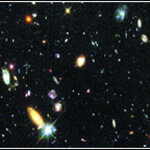Physics

Physicists at the Commerce Department's National Institute of Standards and Technology (NIST) have taken the first ever two-dimensional pictures of a "frequency comb," providing extra information that enhances the comb's usefulness in optical atomic clocks, secure high-bandwidth communications, real-time chemical analysis, remote sensing, and the ultimate in precision control of atoms and molecules.
False-color images of the "fingerprints" of molecular iodine, each taken under different experimental conditions using a NIST frequency brush created with an ultrafast visible laser. The squares…

Researchers at the National Institute of Standards and Technology (NIST) have developed a sensitive new method for rapidly assessing the quality of carbon nanotubes. Initial feasibility tests show that the method not only is faster than the standard analytic technique but also effectively screens much smaller samples for purity and consistency and better detects sample variability.
A new NIST method for rapidly assessing the quality of carbon nanotubes was evaluated in part by comparing the results to electron micrographs, which revealed uneven composition such as large bundles of nanotubes…

Nanoscale magnets in the form of iron-containing molecules might be used to improve the contrast between healthy and diseased tissue in magnetic resonance imaging (MRI)--as long as the concentration of nanomagnets is carefully managed--according to a new report* by researchers at the National Institute of Standards and Technology (NIST) and collaborators. Molecular nanomagnets are a new class of MRI contrast agents that may offer significant advantages, such as versatility in design, over the compounds used today.
NIST studies show that molecular nanomagnets create concentration-dependent…

Peering backward in time to an instant after the big bang, physicists at the University of Wisconsin-Madison have devised an approach that may help unlock the hidden shapes of alternate dimensions of the universe.
A new study demonstrates that the shapes of extra dimensions can be "seen" by deciphering their influence on cosmic energy released by the violent birth of the universe 13 billion years ago. The method, published today (Feb. 2) in Physical Review Letters, provides evidence that physicists can use experimental data to discern the nature of these elusive dimensions - the existence of…

For the first time physicists have shown that well structured chaos can be initiated in a photonic integrated circuit. Furthermore, this represents the first time scientists have been able to study optical chaos at gigahertz rates.
The output of a semiconductor laser is normally regular. However, if certain laser parameters are tweaked, such as by modulating the electric current pumping the laser or by feeding back some of the laser's light from an external mirror, the overall laser output will become chaotic; that is, the laser output will be unpredictable.
To make the chaos even more…

A new cosmological model demonstrates the universe can endlessly expand and contract, providing a rival to Big Bang theories and solving a thorny modern physics problem, according to University of North Carolina at Chapel Hill physicists.
The cyclic model proposed by Dr. Paul Frampton, Louis J. Rubin Jr. distinguished professor of physics in UNC’s College of Arts & Sciences, and co-author Lauris Baum, a UNC graduate student in physics, has four key parts: expansion, turnaround, contraction and bounce.
During expansion, dark energy -- the unknown force causing the universe to expand at an…

John Conway says, "I’ve been looking for the Higgs boson for almost 20 years" which sounds like a long time if you are a young scientist but I have a watch missing for 35, so it isn't that impressive.
What is impressive his description of what happened when he thinks he found Higgs at CERN.
I thought the only "Quark" I would ever see was that TV show in the 1980s but sometimes scientific progress creeps and sometimes it leaps. We may be in for a leap.
Anyway, I can't do the article any justice here. Go there and read it for yourself and by the time you come back I will have something to…

Scientists have made the astonishing discovery that sound might drive supernovae explosions. Their computer simulations say that dying stars pulse at audible frequencies – for instance, at about the F-note above middle C – for a split second before they blow up.
Researchers in the 1960s began using computer models to test ideas about what, exactly, causes stars to explode. But mathematical simulations have so far failed to satisfactorily explain the inner workings of nature's most spectacular blasts.
Neutrinos – subatomic particles widely thought to power supernovae explosions –don't seem to…